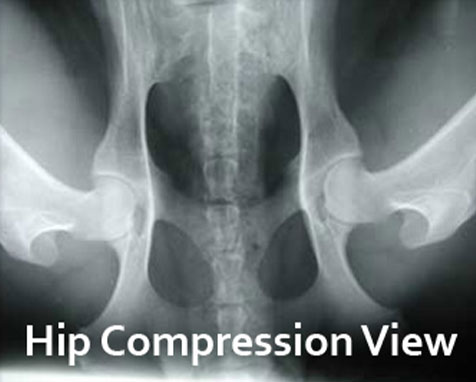Diagnosing Hip Dysplasia in Dogs with the PennHIP Method
Hip dysplasia is an abnormal formation of the hip socket that, in its more severe form, can eventually cause crippling lameness and painful joint arthritis in your dog. It is a genetic (polygenic) trait that is affected by environmental factors. Dr. Young is certified to evaluate hip joint confirmation in dogs using the PennHIP method. She is pleased to offer it to the Charlotte, NC pet community.
In 1983, Dr. Gail Smith, a veterinary researcher at the University of Pennsylvania School of Veterinary Medicine, conceived and developed a new scientific method for the early diagnosis of Canine Hip Dysplasia (CHD). This program, called PennHIP (University of Pennsylvania Hip Improvement Program), measures hip joint laxity and can accurately predict the onset of degenerative joint disease in dogs as young as 16 weeks of age.
Learn more about the PennHIP program and treating hip dysplasia in dogs.

Diagnosis
Hip dysplasia begins early in life, and as it progresses, it causes a deformation of the hip joint as well as the development of DJD (degenerative joint disease--commonly called arthritis). It can be seen in almost all dog breeds, although it occurs most commonly in the large and giant breeds. Radiography (X-ray) is the only method for accurately diagnosing hip dysplasia in dogs and, presently, the PennHIP technique is the most accurate technique available for evaluating the condition.
Evaluation
To obtain diagnostic quality radiographs, the musculature around the hip joint must be completely relaxed. For the comfort and safety of your pet, this requires either heavy sedation or general anesthesia, which is carefully determined and administered by the veterinarian performing the PennHIP procedure.
After the radiographs are taken, they are submitted to PennHIP for evaluation. You, the pet owner, and our participating PennHIP veterinarian receive your dog’s Hip Evaluation Report in the mail, which will give you and our staff information to accurately predict your dog’s susceptibility to developing DJD.


Selective Breeding
The only current method for reducing the occurrence of hip dysplasia in dogs is by selective breeding. Dr. Young and her staff recommend that only dogs that have sound hips, with no radiographic signs of hip dysplasia, should be used for breeding. Dogs with radiographic signs of hip dysplasia should not be used for breeding and should be neutered at the appropriate age.
